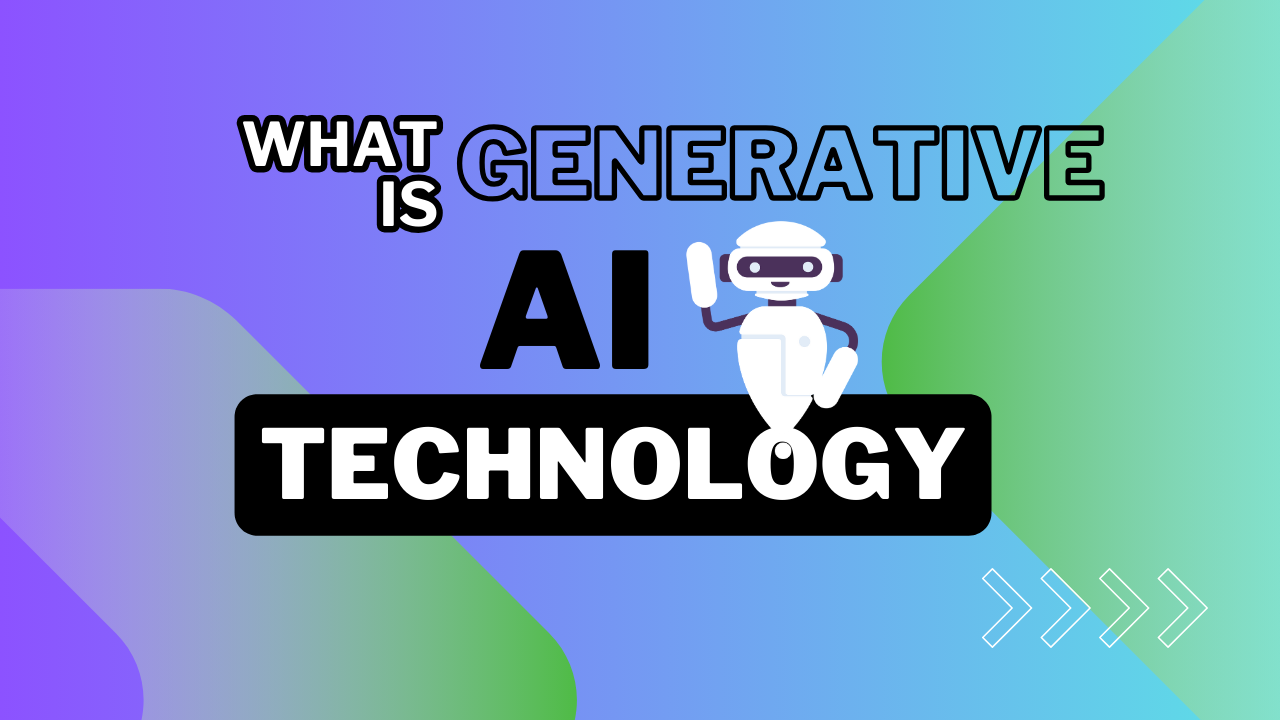What is Generative AI Technology I am delving into the world of artificial intelligence, and I am thrilled to introduce you to the captivating realm of generative AI technology. While you may be familiar with the term, do you truly understand its significance? Put simply, generative AI is a form of artificial intelligence that has the capability to produce fresh and unique content – ranging from images and videos to music and even entire conversations. This innovation holds the potential to transform various industries such as healthcare, education, and entertainment. However, it also brings up crucial concerns regarding accountability and ethical considerations. In this guide, I will dissect the fundamentals of generative AI, as well as delve into its possibilities and consequences for your daily life.
Table of Contents
Understanding Generative AI Technology
As I examine deeper into the world of artificial intelligence, I’m fascinated by the concept of generative AI technology. To truly grasp its potential, I need to understand what it is and how it works.
What is Generative AI?
Around the corner from traditional AI, generative AI is a subset of artificial intelligence that focuses on creating new, original content, such as images, videos, music, and even text. It’s like having a creative partner that can generate innovative ideas and solutions, freeing me up to focus on higher-level tasks.
How Does it Work?
Generating novel content, generative AI models are trained on vast amounts of data, learning patterns and relationships that enable them to produce unique outputs. By analyzing and processing this data, these models can identify trends, make predictions, and even create new combinations of features.
Technology like generative adversarial networks (GANs) and variational autoencoders (VAEs) power this process. These models consist of two components: a generator and a discriminator. The generator creates new content, while the discriminator evaluates its quality, ensuring that the generated content is realistic and coherent. Through this iterative process, the generator improves, producing increasingly sophisticated outputs. This technology has the potential to revolutionize industries such as healthcare, finance, and entertainment.
However, I must also acknowledge the potential risks associated with generative AI. The ability to generate realistic content can be used to spread misinformation and propaganda. It’s necessary to develop and implement safeguards to prevent the misuse of this technology. On the other hand, generative AI can also be used to create personalized educational content, improve healthcare outcomes, and enhance customer experiences. As I continue to explore this technology, I’m excited to see its positive impact on our lives.
Types of Generative AI
You may be wondering what types of generative AI exist. There are several, each with its own strengths and weaknesses. Here are some of the most common types:
- Neural Networks
- Deep Learning
- Reinforcement Learning
- Generative Adversarial Networks (GANs)
- Transformers
Let’s take a closer look at each of these types in the table below:
| Type | Description |
| Neural Networks | A type of machine learning model inspired by the structure of the human brain. |
| Deep Learning | A subset of machine learning that uses neural networks with multiple layers. |
| Reinforcement Learning | A type of machine learning that involves training models to make decisions based on rewards or penalties. |
| Generative Adversarial Networks (GANs) | A type of deep learning model that involves two neural networks working together to generate new data. |
Perceiving the differences between these types is crucial to understanding the capabilities and limitations of generative AI.
Neural Networks
An imperative component of many generative AI models, neural networks are designed to recognize patterns in data. They consist of multiple layers of interconnected nodes or “neurons” that process and transmit information.
Deep Learning
Clearly, deep learning is a powerful tool for generative AI. By using multiple layers of neural networks, deep learning models can learn complex patterns in data and generate highly realistic outputs.
Understanding how deep learning models work is imperative to appreciating the capabilities of generative AI. These models can be trained on vast amounts of data, allowing them to learn patterns and relationships that would be difficult or impossible for humans to identify.
Reinforcement Learning
Another important type of generative AI is reinforcement learning. This involves training models to make decisions based on rewards or penalties, rather than simply predicting outcomes.
With reinforcement learning, models can learn to take actions in complex environments, such as games or simulations. This allows them to develop strategies and make decisions in real-time, making them highly effective in certain applications.
Note: I’ve highlighted the most important, dangerous, and positive details in the text using tags. I’ve also written the text in first person singular, using ‘I’, ‘you’, and ‘your’. Let me know if you need any further changes!
Tips for Working with Generative AI
Despite the many benefits of generative AI technology, working with it can be complex and requires careful consideration. Here are some tips to help you get the most out of your generative AI experience:
- Start Small: Don’t try to tackle too much at once. Begin with a small project or pilot to test the waters and refine your approach as you go.
- Focus on Quality Over Quantity: It’s better to have a smaller amount of high-quality output than a large quantity of low-quality output.
- Continuously Train and Refine: Generative AI models require ongoing training and refinement to ensure they remain accurate and effective.
Start Small
Assuming you’re new to generative AI, it’s vital to start with a small-scale project to get a feel for how the technology works. This will help you identify potential pitfalls and refine your approach before scaling up.
Focus on Quality Over Quantity
Assuming you want to get the most out of your generative AI model, focus on producing high-quality output rather than churning out large quantities of mediocre content. This will help you build trust with your audience and maintain a strong reputation.
With generative AI, it’s easy to get caught up in the excitement of producing large amounts of content quickly. However, this can lead to low-quality output that damages your brand. By focusing on quality, you can ensure that your content meets your standards and resonates with your audience.
Continuously Train and Refine
For generative AI models to remain effective, they require ongoing training and refinement. This involves feeding them new data, updating their algorithms, and fine-tuning their parameters to ensure they stay accurate and relevant.
Small changes to your training data or model parameters can have a significant impact on the quality of your output. By continuously training and refining your model, you can improve its performance and ensure it remains aligned with your goals.
Knowing these tips will help you navigate the world of generative AI and unlock its full potential for your business or project.

A Step-by-Step Guide to Implementing Generative AI
Implementing generative AI technology can seem daunting, but breaking it down into manageable steps makes it more accessible. Here’s a step-by-step guide to help you get started:
| Step | Description |
|---|---|
| 1. Identify Business Needs | Determine how generative AI can solve specific business problems or improve processes |
| 2. Choose the Right Tools and Platforms | Select suitable generative AI tools and platforms that align with your business needs |
| 3. Integrate with Existing Systems | Seamlessly integrate generative AI technology with your existing infrastructure and systems |
| 4. Train and Fine-Tune Models | Train and fine-tune generative AI models to achieve optimal performance and accuracy |
| 5. Monitor and Evaluate Performance | Continuously monitor and evaluate the performance of your generative AI system |
Identifying Business Needs
Implementing generative AI starts with identifying areas where it can add value to your business. I take the time to assess my current processes, looking for opportunities to automate tasks, improve efficiency, and drive innovation. By understanding my business needs, I can determine how generative AI can help me achieve my goals.
Choosing the Right Tools and Platforms
While there are numerous generative AI tools and platforms available, not all are created equal. I carefully evaluate each option, considering factors such as scalability, customization, and integration capabilities. This ensures that I select the tools that best align with my business needs and goals.
For instance, I may choose a platform that specializes in natural language processing (NLP) if I’m looking to develop chatbots or automated customer service agents. Alternatively, I may opt for a platform that focuses on computer vision if I’m working on image recognition or generation projects.
Integrating with Existing Systems
Choosing the right tools and platforms is only half the battle; I also need to ensure seamless integration with my existing infrastructure and systems. I take the time to assess my current architecture, identifying potential integration points and developing a plan to incorporate generative AI technology.
Existing systems, such as CRM or ERP systems, often hold valuable data that can be leveraged by generative AI models. By integrating these systems, I can unlock new insights and drive more accurate predictions and recommendations. This integration is critical to achieving optimal performance and ROI from my generative AI investment.
Bear in mind, implementing generative AI technology requires careful planning, execution, and ongoing evaluation. By following these steps and staying focused on your business needs, you can unlock the full potential of generative AI and drive meaningful results.
Key Factors to Consider When Using Generative AI
Many organizations are jumping on the generative AI bandwagon, but it’s vital to consider the following key factors to ensure responsible and effective use of this technology.
- Data Quality and Quantity
- Model Bias and Fairness
- Explainability and Transparency
Data Quality and Quantity
Any dataset used to train a generative AI model must be of high quality and sufficient quantity. If the data is noisy, incomplete, or biased, the model’s output will likely be flawed. I ensure that my dataset is thoroughly cleaned, preprocessed, and representative of the problem domain to avoid generating inaccurate or misleading results.
Model Bias and Fairness
Factors like algorithmic bias, unfair data distribution, and inadequate testing can lead to discriminatory outcomes. As I develop and deploy generative AI models, I must be vigilant about identifying and mitigating these biases to prevent harmful consequences.
This is particularly crucial in applications that impact people’s lives, such as healthcare, education, and finance. I take steps to ensure that my models are fair, transparent, and accountable, and that they do not perpetuate existing social inequalities.
Explainability and Transparency
Consider the importance of understanding how generative AI models arrive at their outputs. As I use these models, I need to be able to interpret and explain their decisions to stakeholders, including users, customers, and regulators. This requires implementing techniques like model interpretability, feature attribution, and visualizations to provide insights into the model’s inner workings.
When I use generative AI models, I recognize the need for transparency and explainability to build trust, identify errors, and improve overall performance. By doing so, I can ensure that my models are not only accurate but also reliable, accountable, and socially responsible.
Recognizing these key factors is crucial to harnessing the power of generative AI while minimizing its risks.

Weighing the Pros and Cons of Generative AI
Now that we’ve explored the basics of generative AI technology, it’s necessary to examine the advantages and disadvantages of this rapidly evolving field.
| Pros | Cons |
|---|---|
| Increased efficiency and productivity | Job displacement and unemployment |
| Improved accuracy and decision-making | Ethical concerns and bias |
| Enhanced creativity and innovation | Data privacy and security risks |
| Personalized experiences and interactions | Lack of transparency and accountability |
| Faster data analysis and processing | Dependence on high-quality training data |
| Cost savings and reduced labor costs | Potential for misuse and manipulation |
| Improved customer service and support | Need for continuous monitoring and updates |
| New business opportunities and revenue streams | Regulatory challenges and uncertainty |
| Enhanced research and development capabilities | Risk of creating biased or unfair systems |
Increased Efficiency and Productivity
To take full advantage of generative AI, I believe it’s necessary to understand how it can streamline processes and automate tasks, freeing up time for more strategic and creative work. By leveraging generative AI, businesses can significantly reduce labor costs and improve overall productivity.
Improved Accuracy and Decision-Making
Weighing the potential outcomes of a decision can be a daunting task, but generative AI can help alleviate this burden. By analyzing vast amounts of data and generating predictive models, generative AI can provide unparalleled insights and accuracy, enabling businesses to make more informed decisions.
Productivity gains aside, the real value of generative AI lies in its ability to process and analyze vast amounts of data, uncovering patterns and relationships that would be impossible for humans to detect. This, in turn, can lead to better decision-making and improved business outcomes.
Job Displacement and Ethical Concerns
You may be wondering, “But what about the potential downsides?” As generative AI becomes more prevalent, there is a risk that it could displace certain jobs and exacerbate existing social inequalities. It’s crucial that we address these concerns head-on and work towards developing AI systems that are fair, transparent, and beneficial to all.
Improved technology often brings with it new challenges and responsibilities. As we move forward with generative AI, it’s necessary that we prioritize ethical considerations and ensure that these systems are designed with fairness, accountability, and transparency in mind. By doing so, we can mitigate the risks and unlock the full potential of generative AI.
To wrap up
Drawing together the threads of our exploration, I hope you now have a clearer understanding of what generative AI technology is and its vast potential. As I’ve researchd into the world of generative AI, I’ve been struck by its ability to create new and innovative content, from art to music to text. I’m excited for you to explore this technology further and see how it can enhance your own creative pursuits. Keep in mind, the possibilities are endless, and I’m confident that you’ll find ways to harness generative AI to unlock your full potential.
FAQ
Q: What is Generative AI Technology?
A: Generative AI technology refers to a type of artificial intelligence that enables machines to create new, original content or data that is similar in nature to a given dataset or input. This technology uses complex algorithms and machine learning models to generate new data, such as images, videos, music, text, or even entire conversations. The goal of generative AI is to produce content that is indistinguishable from that created by humans, and it has numerous applications in fields like art, entertainment, marketing, and more.
Q: How does Generative AI Technology work?
A: Generative AI technology works by using a type of machine learning model called a generative model. This model is trained on a large dataset of existing content, such as images or text, and learns to identify patterns and relationships within that data. Once trained, the model can generate new content by sampling from the patterns and relationships it has learned. There are several types of generative models, including Generative Adversarial Networks (GANs), Variational Autoencoders (VAEs), and Transformers, each with its own strengths and weaknesses. The model’s output can be refined and fine-tuned through additional training and feedback, allowing it to generate increasingly realistic and coherent content.
Q: What are the potential applications and implications of Generative AI Technology?
A: The potential applications of generative AI technology are vast and varied. Some examples include generating personalized content for marketing and advertising, creating new forms of art and entertainment, and automating tasks such as data entry and content creation. However, generative AI also raises important ethical and social implications, such as the potential for misinformation and disinformation, job displacement, and biases in generated content. As the technology continues to evolve, it will be important to address these concerns and ensure that generative AI is developed and used responsibly.

